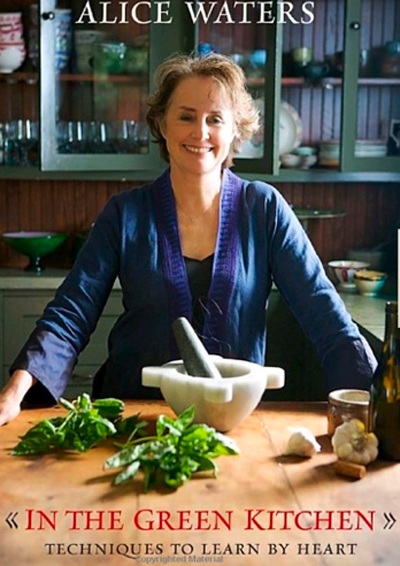culinary heroes
Who are your culinary heroes? I have several; Julia Child, of course, and Jacques Pépin to name only two. Then there is my friend and mentor, Barbara Fenzl.
Another is Alice Waters, the owner of the world-renowned Berkeley, California restaurant, Chez Panisse. Ms. Waters opened Chez Panisse in 1971 when she was only 27 years old. Since that time it has become one of the most awarded restaurants in the world and she has been cited as the most influential culinary person in the past 50 years and is considered the mother of American food. Add to that the fact that Ms. Waters has been a leading proponent of the local and the organic food movements for more than 40 years, long before you could find organic produce in just about every grocery store. Before I go on, please know that the picture above of Alice Waters is not how she typically dresses, she is innovative, but not necessarily eccentric! The photo is her Halloween costume at a 2008 benefit at which she was honored for her amazing works.
Her philosophy is based on the principle that access to sustainable seasonal food is a right, not a privilege. In 1996 she founded the Chez Panisse Foundation and created the Edible Schoolyard program at the Martin Luther King Middle School in Berkeley. She is a hero indeed.
In April 2010 she shared the seven essentials of “a green kitchen” and why they are important, with The Globe and Mail. Honestly, I’m down with six of these essentials, #6 may be a bit of a problem where I’m concerned… no food processor – no thank you! But I figure I make up for it with my extra effort on #7…
1. Make your own vinaigrette
“It’s just essential in my life to have a salad, and once you learn how to make that basic vinaigrette, (a mixture of olive oil, red wine vinegar, salt, pepper, and garlic clove) there’s just no end to the variations. It’s so mysterious to a lot of people who don’t eat salad, and think vinaigrette is a strange French word. We’re trying to demystify that, and to differentiate between what’s in a bottle and what you can make at home.”
2. Make stock
“It’s a great way to use those bits and pieces of cooking you may otherwise throw away – leftovers from a chicken or the vegetable and parsley stems. I was intimidated for a long time around making stock because you’ve got to get the right amount of water, or if you cook it too long the bone tastes funny, and how much do you reduce it? But it’s actually quite a simple process.”
3. Blanch and wilt greens
“This is an essential in my life. You need greens, and you need to not be frightened by all those leaves, and how to make them manageable and flavourful. Whether they are little greens to go into a soup or served as a side to some piece of fish, or whether they are chopped and added to stuffings or meatballs – they are incredibly nutritious and delicious.”
4. Plant a herb garden
“The really remarkable and dramatic change that you can make to a dish can come through the herbs and the spices that you use. You just don’t get the same flavor with dry herbs. So you can grow some of these herbs quite easily, and a lot of them are very hardy and stay around all year long, like rosemary, thyme, and oregano.”
5. Cook fruit
“It’s great to know how to bake fruit or make jam or a little compote. Because sometimes when you buy fruit, you don’t eat it as quickly as it ripens. Learning how to use the fruit instead of wasting it is important. Just simply cutting, say, apples, sprinkling them with a little sugar, and putting them in the oven renders one of the most heavenly baked fruit dishes you could have. There’s nothing to it.”
6. Be minimalist
“I think that the minimum amount of equipment in the kitchen is very desirable. When you get all those gadgets, you disengage with food, whereas if you use a mortar and pestle, or you’re chopping instead of using a machine, you begin to feel empowered and you take responsibility for what you’re making.”
7. Enlist kids as helpers
“Engage your kids in the cooking of the food, setting of the table, and the conversation. Even if it only happens once a week, you gotta do it. Because they have to grow up with a set of values that ensure that the planet is going to exist. They have to be stewards of the land, and know-how to fend for themselves and how to communicate at the table.”
The photo on the cover of the cookbook above is taken in Ms. Waters’ home kitchen. CLICK THIS LINK for a more extensive look as featured in Vanity Fair. Something you can not see in the photos is a large, brick fireplace. At waist level, the open fireplace has a Tuscan grill and a rotisserie for meat. Folding metal doors can be closed if the fireplace is cold. The ashes fall to a lower compartment for easy collection; the hot ash pile can be used to cook truffles or potatoes. Eventually, the ashes are spread in a backyard vegetable garden.
The fireplace is used continually in winter, for everything from grilling fresh vegetables to making toast. At one side of the fireplace is a wood-burning oven for baking bread or pizza. Beautiful – I’m a bit green with envy!







4 comments
Dear Linda,
Just back from la belle France and was thrilled to read today’s blog. Thanks for the lovely honor of being one of your mentors and for the delightful article about Alice.
Love you,
Barbara
Barb, welcome home! I’ll give you a day or so before I bother you with a phone call! xoxox
Thanks for sharing. I’ve ordered “In the Green Kitchen”. Can we go on a field trip? I still like being in your kitchen best!
Ronnie, excited that you ordered the book and yes, another field trip is in order! xoxo
Leave a Comment